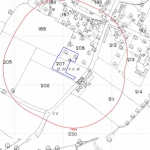Residential Redevelopment of Industrial Buildings at Staythorpe Road, Averham, NG23
Case Study Reference: CS21-11-01
Planning Authority: Newark and Sherwood District Council
Planning Reference: 20/00021/FUL and 21/02443/DISCON
Synopsis:
 As the site had an industrial legacy the site had the potential to be impacted by elevated concentrations of contamination and due to this a contaminated land planning condition was attached to the decision notice for the proposed development (erection of two dwellings).
As the site had an industrial legacy the site had the potential to be impacted by elevated concentrations of contamination and due to this a contaminated land planning condition was attached to the decision notice for the proposed development (erection of two dwellings).
The first stage in discharging the contaminated land planning condition was to prepare a Phase I desk study report, this assesses the potential issues that may affect the site by reviewing the history of the site and data held by regulatory bodies (Environment Agency, local authority, BGS etc.).

 The site history was reviewed by using Ordnance Survey maps, aerial plates and street level imagery, this revealed that the site was developed circa 1899 with the 1919 map identifying the site as a saw pit. The 1956 map identified a building on the southern area which was later identified as a dwelling.
The site history was reviewed by using Ordnance Survey maps, aerial plates and street level imagery, this revealed that the site was developed circa 1899 with the 1919 map identifying the site as a saw pit. The 1956 map identified a building on the southern area which was later identified as a dwelling.
The review of the history of the surrounding area did not reveal any off site potential sources of contamination.
A review of the planning history of the site revealed a number of previous applications for the site, this revealed the site had bene used as a joinery.
Data provided by the Environment Agency identified a heap and workings to the south of the site as well as a pond to the east and a smithy to the east.
O
 n completion of the desk based assessment the site was subject to a walkover survey in order to further refine the assessment, this revealed that the site had been cleared with only the floor slabs of the previous buildings present. Damaged cement sheeting was noted on the site.
n completion of the desk based assessment the site was subject to a walkover survey in order to further refine the assessment, this revealed that the site had been cleared with only the floor slabs of the previous buildings present. Damaged cement sheeting was noted on the site.
On completion of the walkover survey a qualitative risk assessment was undertaken on the potential source of contamination identified in the desk study report and this concluded that the past uses of the site, thew potential for made ground to be present and the damaged cement sheeting required further works.
The site investigation comprised of the excavation of a number of trial pits across the site in order to determine the presence and extant of made ground on the site was well as obtaining samples for chemical testing. Surface samples were taken in order to assess the risk posed by asbestos fibres.
The assessment of the chemical data revealed that the made ground was impacted with elevated concentrations of contamination as well as the natural soils. Asbestos was also recorded in one surface sample.
In order to break the pollution linkages identified a 600mm cover underlain by a geotextile was proposed om the garden and landscaped areas with a surface scape for plts where no made ground was recorded.
The recommendations of the report were accepted and the only outstanding issue was the submission of the information to demonstrate the remediation.




